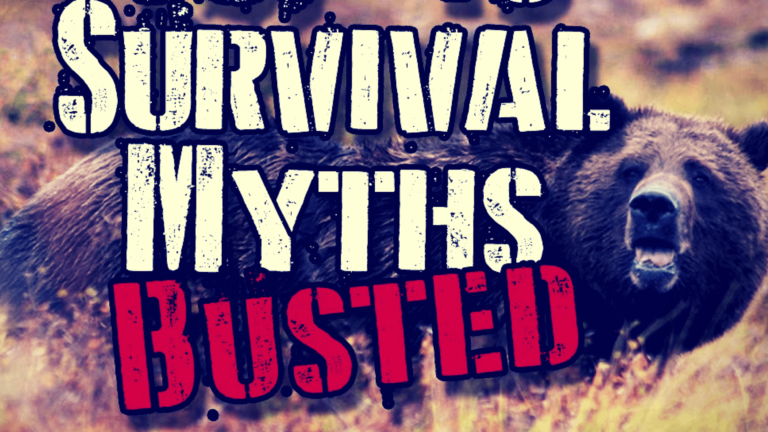We can see more and more people wearing a paracord wristband around the wrist, and talk about survival which they saw on a movie or TV series .
But what the media usually conveys does not reflect what real survival requires, and so myths are born.
Depending on the context, some may prove particularly dangerous, and it is essential for the prepper to know the main ones, so as not to succumb to the sirens of misinformation …
Although the media, at least the good ones, could have a positive impact on the number of people preparing, it goes without saying that an ordinary viewer would have difficulty surviving in a scenario of chaos, whether it be The consequence of a natural or man-made disaster. If people continue to develop a false sense of security such as one who is being tended to drawing for the sole purpose of entertaining them, then there is no doubt that the overwhelming majority will perish in case a scenario of this kind comes to be produce.
If you talk to ordinary people who think they are a minimal informed about survival, you will realize that there are a number of myths that have been instilled in them. These people believe in it and do not even ask themselves whether they are true or false. They think that when the time comes to put them into practice, they will be ready, and that knowledge will save their lives.
This article aims to revisit some of these “rules of survival“, and give readers of PrepperTidbits an additional chance to pass through an emergency situation by avoiding to follow them …
Myth 1. Fire? no problem !
Most people think that making fire is an obvious and easy thing, including in an unfamiliar environment. This could be true if you have a lighter in your pocket or even a few matches, but without these things, among other things, you will learn in the hard way that this is not really the case. Rubbing two sticks together does not work as well as in movies, and fire by friction, as it is called, is anything but obvious.

Experienced survivalists know that starting a fire without the right equipment is a daunting task. It takes time, and more importantly, it takes a lot of patience. There are many factors that come into play, such as having the right equipment on hand, humidity, experience, and so on. Even the aborigines who have a thousand years of experience always carry their instruments in their wallets because they know very well that friction does not happen with the first pieces of wood coming.
Firing without modern means is a skill that takes time to be mastered, and you should never assume that such a thing is evident in a survival situation. If you want to stay alive on a chilly night, then it would be better if you had the tools to light a fire permanently.
Myth 2. First you have to eat to stay strong
We are a generation that eats more than three times a day, and we are programmed to consider food as a priority. This may be true in everyday life, but when in the woods or in an emergency scenario, eating should only be considered after taking care of all other survival tasks.
Finding water and being able to purify it is what comes first. Setting up a shelter and starting a fire to preserve hypothermia are the next two important things that will keep us mentally prepared to face what might happen next. These vital tasks should therefore be accomplished even before thinking about filling the belly! Humans are able to survive entire weeks before they actually starve. Even if your stomach blows you divergent instructions, you should not follow them but instead stay focused on your priorities.
Myth 3. Hypothermia only occurs in cold climates
It is perhaps the myth that would lead to the most “natural” deaths in a survival scenario. One can not be more wrong, and there are many factors that can make hypothermia a harsh reality. A damp environment, a wind blowing, a sufficient elevation … It takes no more. Such conditions can be found almost everywhere, and it matters little whether you are in the ruins of a building or in the middle of the forest.
To stay alive, you should follow a simple rule: Keep dry and warm. This is all it takes to prevent body temperature from falling to a level dangerous to physical integrity. Always have a poncho when you go on a mop, dry clothes that may be damp, add an insulating layer between you and the floor, make a fire, and so on. All these measures will allow you to maintain an acceptable body temperature, and you will live one more day. There is no need for snow and ice to bring hypothermia, and it can happen in any environment.
Myth 3. It’s running water, so drink up
It is one of those myths that are transmitted from generation to generation. We often think that if it is water running, for example that of a pretty mountain river, then it is necessarily clean and drinkable. It was not true decades ago, when pollution was not really a problem, and it is even less so nowadays. In fact, drinking from this kind of source practically involves playing Russian roulette.
In nature there is a good chance that you can not find naturally drinkable water. After walking for hours in full sun, the sound of a river could tempt you … Yet you should absolutely resist the temptation to thirst your thirst. Bacteria, viruses and other parasites can hide even in the most crystalline waters. All these pathogenic aquatic organisms wait patiently to enter your body, and to create potentially fatal problems there.

If you drink untreated and unfiltered water, you will probably end up with diarrhea, vomiting or nausea, at best. These are symptoms that you must absolutely avoid in a survival situation because they can lead to a physical collapse. You should purify the water you need, including that to wash your face. In order to avoid such discomfort, it is essential to always carry with you a water filter as well as a purification means such as iodine, silver or chlorine pellets.
Also know that boiling is a good way to kill MOST bacteria and other contaminants. However, you should know that boiling water will not kill everything in it and that it will not be 100% safe. It is not for nothing that companies like LifeStraw and others spend millions every year to develop filters. If your only option is boiling, then it will always be better than nothing, but in absolute terms, you should know that this will not guarantee total safety.
Myth 4. Wild plants will feed me
Thinking that you will be able to pick up wild plants at the turn of your walks, and that they will allow you to survive, is a stake wish which will prove to be a fatal mistake when the time comes. The vast majority of wild plants are not edible or will make you sick to death if they do not kill you, even if they look sympathetic at first sight.
We hear a lot of survivalists talking about gathering in the woods, especially mushrooms. Knowing that a priori edible species like morels can cause fatal poisoning, not to mention the others. Collecting is an expertise that takes years of practice, and even very experienced people can make mistakes when it comes to selecting the right species. The book you have planned to carry with you will not make you infallible; Mistakes can happen, and you should always avoid eating something you are not 100% sure that it is actually edible. It’s better to stay hungry and healthy rather than swallowing food that will kill you.
In addition, unless you have animal proteins, you will never be able to harvest enough calories to feed you enough, including meeting your energy needs if your physical expenses are high. Vegetable proteins are a complement; They will allow you to survive only if you do not have to struggle for your other basic needs, ie shelter and heating, or if you do not have to produce prolonged physical effort.
Myth 5. Suck the venom of a snake or a spider and you will survive
The venom of a snake or spider will penetrate your bloodstream almost immediately after you have been bitten. In the movies, we sometimes see the hero make an X with a knife on the wound, and suck the poison to gain a little time. This is probably the worst thing to do. Instead of winning, you will lose precious time that you could have used to do things likely to save you, such as calling for help if they are available.
This is a particularly tough myth in people’s minds. They are unaware that the residual venom around the sting could seriously affect your mouth and lips. Worse than that, if you swallow it, your internal system would also be affected and you would reduce your chances of survival. Instead of charging yourself and experiencing the nonsense that you see in movies, you should seek the assistance of a professional as quickly as possible.
I remind those who do not know that the only viable solution in case of snake bite is to put a tourniquet that will be loosened at regular intervals so as to slow as much as possible the rise of the venom towards the heart. Of course, it would be necessary to move as little as possible, in order not to activate the blood circulation.
Know that if you do not have an antivenom and you are far from everything, there will be charcoal which is an extraordinary antidote in case of poisoning, whatever its origin, from poisonous mushrooms to Strychnine through the creatures. If you have burned the day before or if you pass through any other place that can house coal, reduce it to powder and absorb 50 grams in water, to be renewed every two hours if necessary.
Next the places you intend to cross and the nature of the danger, it could be particularly wise to fit in your backpack a box activated charcoal , in anticipation of the unexpected. It could be your only plank of salvation! If you have not planned it and you are in an area at risk, then it would be wise to build up a small stock of coal over the days that you will keep with you.
Myth 6. Hunting and fishing will provide me with something to eat
Most people will think that animals and fish exist in large numbers in nature, and that they are just waiting for them to be taken. Even if Rambo manages to tinker with a knife and make a wild pig in passing, enough to give him a large amount of bacon, that does not mean you will have the same success once in the woods. First, facts must be separated from fiction, and secondly, hunting and fishing require practice as well as extensive knowledge if you really want to make a living from it.
Even with the most sophisticated hunting weapons or fishing lines, getting a meal is not an easy thing. Becoming an excellent hunter or fisherman requires a great deal of practice, even when equipped with all the equipment you could imagine. How do you think things will happen to you if you are caught unexpectedly in a survival situation, and you are not prepared?
You must study your region in particular, the game you are likely to find there, how to capture it, and above all, prepare it for consumption. If you want to improve your chances of survival in the woods, you will have to learn how to set traps, as well as nets or containment pens for fish. Even with all this knowledge, chances for you to make a good meal might very well never show up.
Myth 7. I read everything to read and so I am ready
Watching “walking dead”, reading books and magazines or spending thousands of hours on the internet looking for tips on preparation and survival, will not do anything if you are not curious enough to test what you have learnt. The best way to prepare is the experience, and it is only by experiencing accumulated knowledge that you can discover what works for you, how you can improve your skills, and, in so doing, learn from your mistakes. You must be able to distinguish facts from fiction if you want to survive in an apocalypse scenario, and you should always test the information you receive.
If you do not practice what you have learned, you will break down quickly both physically and mentally in a real survival situation. Your best tool is your brain and you should know how to use it and develop a survivor’s state of mind. I’m not saying you’ll have to be an expert or an outstanding survivor, but you should at least have the intelligence to look for alternatives to the problems you might encounter in a crisis scenario.
Conclusion
The myths about survival listed in this article can be easily demystified, and you must question everything before considering it as a fact. Of course, there are others, and we will have the opportunity to come back. In any case, it is up to you to analyze or follow them blindly. When the time comes, it will be too late to learn to distinguish facts from fiction …
